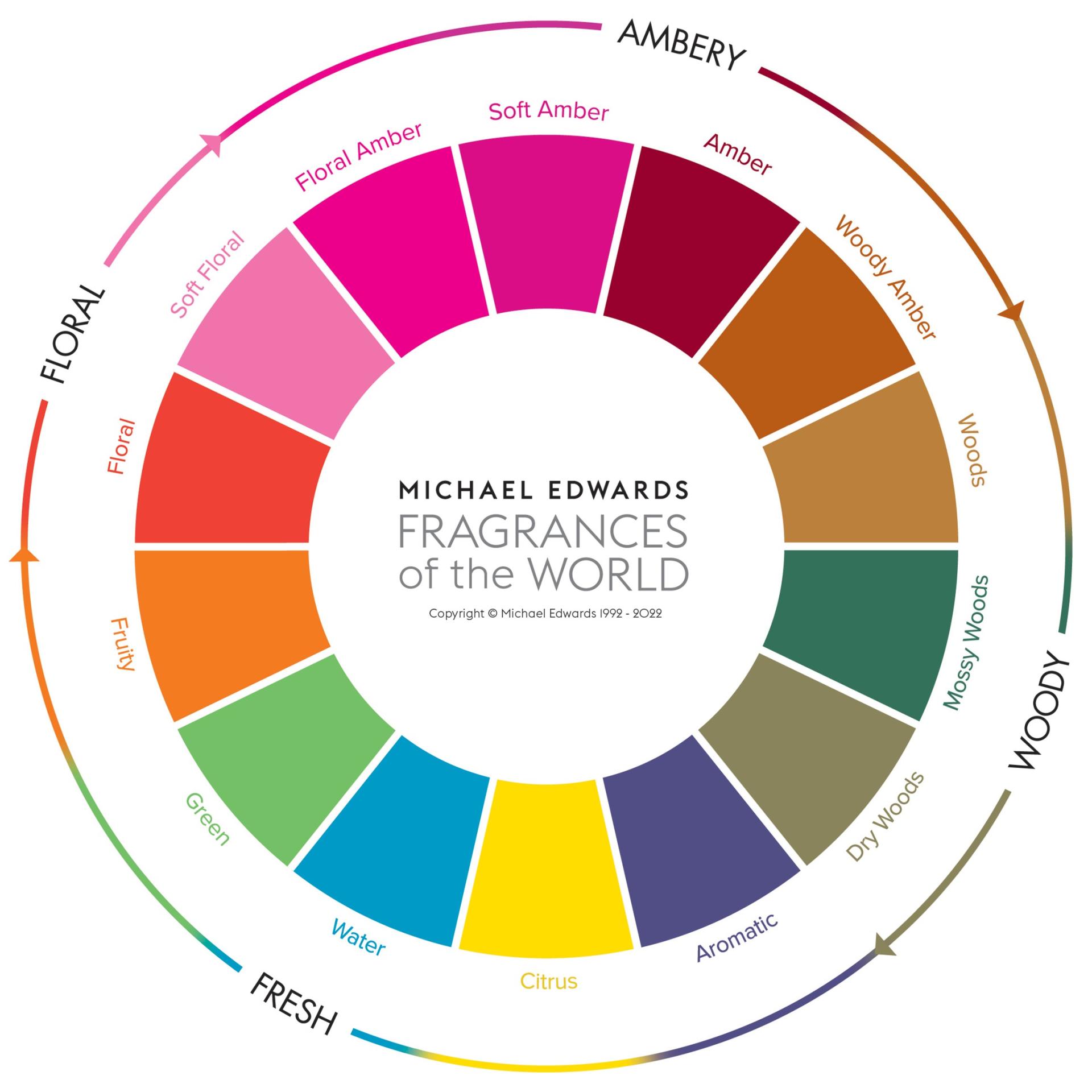Understanding the Fragrance Wheel and How to Use It

Published: Nov 25, 2020 • Last Updated: Jan 10, 2024
The Fragrance Wheel used by the industry today was invented by Michael Edwards and published in his 1992 edition of The Fragrance Manual. This was primarily created for retailers to help them suggest the right perfumes to customers.
It has been iterated over several times since and today, we'll be discussing the latest version of the wheel which is from 2010.

The Fragrance Wheel classifies scents into 4 main families: Ambery, Woody, Fresh and Floral. These families are further subdivided into more specific types of scents for a total of 14 categories.
Each category blends into the adjacent one which signifies how there are no hard boundaries between smells. You can have a mix of Florals and Ambers or Woods and Moss or Citrus and Water and so on.
Fragrance Families
Ambery
The Ambery fragrance family boasts a rich and warm allure, often associated with sophistication and sensuality. Within this family, we encounter four sub-categories:
- Floral Amber: This sub-category seamlessly blends the sweetness of florals with the warmth of amber, creating a harmonious and romantic scent. Example: Orange Blossom
- Soft Amber: Embracing subtlety, soft amber fragrances offer a gentle and comforting experience, making them ideal for everyday wear. Example: Anise
- Amber: The classic amber fragrance is a timeless favorite, characterized by its deep and resinous notes that exude a sense of luxury. Example: Cinnamon, Vanilla, Musk
- Woody Amber: Combining the earthiness of wood with the richness of amber, this sub-category adds an intriguing depth to the fragrance, appealing to those who seek a bold and robust scent. Example: Myrrh
Woody
The Woody fragrance family draws inspiration from the great outdoors, capturing the essence of forests and nature. Divided into three sub-categories:
- Woods: Rooted in the raw and authentic scent of various woods, this category offers a grounding and natural olfactory experience. Example: Cedarwood, Sandalwood, Vetiver
- Mossy Woods: Infused with the earthy and green notes of moss, fragrances in this sub-category bring a touch of wilderness and vitality. Example: Oakmoss
- Dry Woods: Characterized by a crisp and arid quality, dry woods fragrances are crisp and smoky. Example: Tobacco
Fresh
The Fresh fragrance family is a celebration of invigorating and rejuvenating scents, perfect for those who seek a burst of energy. Comprising four sub-categories:
- Aromatic: Often featuring herbal and spicy notes, aromatic fragrances evoke a sense of freshness and vitality. Example: Sage, Lavender
- Citrus: Bursting with the zesty and vibrant essence of citrus fruits, this sub-category is uplifting and energizing. Example: Mandarin, Bergamot
- Water: Inspired by the purity of water, fragrances in this category offer a clean and aquatic experience, reminiscent of ocean breezes and rain showers. Example: Sea Water
- Green: Infused with the crispness of green foliage, these fragrances bring the outdoors to life, creating a revitalizing and harmonious olfactory journey. Example: Fresh cut grass, Cucumber
Florals
The Florals fragrance family is a symphony of delicate and enchanting scents, capturing the essence of blooming flowers. Divided into three sub-categories:
- Fruity: Playful and vibrant, fruity floral fragrances combine the sweetness of fruits with the elegance of floral notes, creating a youthful and joyful experience. Example: Apple, Pear, Berries
- Floral: The quintessential floral category is a celebration of various blossoms, offering a timeless and romantic olfactory journey. Example: Rose, Lilium
- Soft Floral: Embracing a gentle and subtle approach, soft floral fragrances exude an air of understated elegance, making them perfect for any occasion. Example: Jasmine
How to use the Fragrance Wheel
Although the fragrance wheel was made for retailers, it has been a useful tool for us consumers as well. If you are new to perfumes and want to find your perfect scent or a new signature scent, you should use this wheel as we describe below.
The fragrance wheel works similar to a color wheel where each color blends into the ones adjacent to it and how opposite colors on the wheel compliment each other.
Adjacent Categories
You know the kind of scents you like. Even if you've never had a perfume before, you have smelled before, right? You know the kind of fragrances you like and are drawn towards. For me, that's Vanilla.
Start with your favorite smells on the wheel and look at the adjacent categories. For example, Vanilla is in amber category so I could look at Soft Amber and Woody Amber fragrances. Chances are, those perfumes will be appealing to me.
Opposite Categories
Just as adjacent categories can be a good place to start - expanding your horizons - you can be bold and look for something remarkably new.
Again, starting from your favorite category (Amber in my case) look at the category opposite it (Water for me). The opposite fragrances on the wheel go well together so you would probably like that as well. And Voila! You have a very new kind of fragrance in your collection.
Next, you can start expanding into adjacent categories on this new scent as well.
Have any questions? Let us know in the comments!
Never miss another article!
- - Get notified when we publish a new article.
- - No personal information required. Turn off anytime

Preet Singh
I have always been enamored by the power of perfumes to evoke emotions and capture memories. This profound love for fragrances led to the creation of ScentGod, a platform designed to allow everyone the luxury of discovering and wearing premium scents without the commitment of a full-sized purchase. My vision for ScentGod is more than just offering fragrances; it's about sharing passion, creating experiences, and helping people find their signature essence.
Read More


